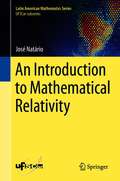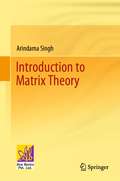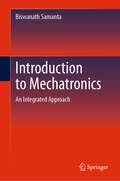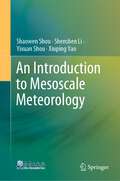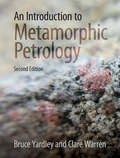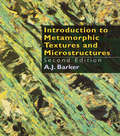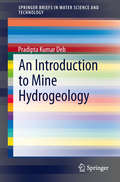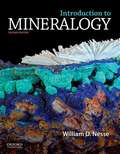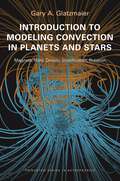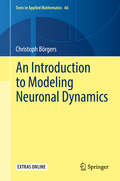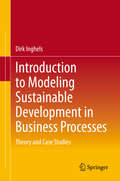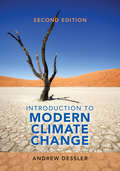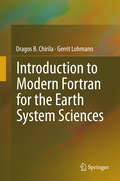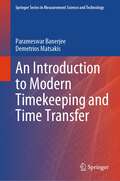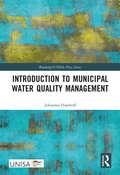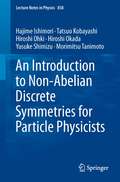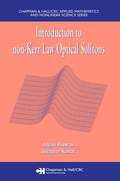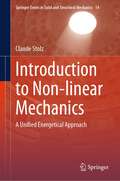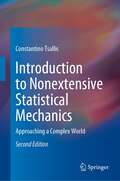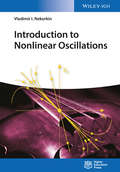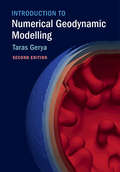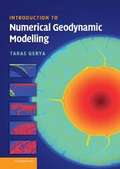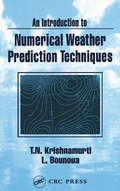- Table View
- List View
An Introduction to Mathematical Relativity (Latin American Mathematics Series)
by José NatárioThis concise textbook introduces the reader to advanced mathematical aspects of general relativity, covering topics like Penrose diagrams, causality theory, singularity theorems, the Cauchy problem for the Einstein equations, the positive mass theorem, and the laws of black hole thermodynamics. It emerged from lecture notes originally conceived for a one-semester course in Mathematical Relativity which has been taught at the Instituto Superior Técnico (University of Lisbon, Portugal) since 2010 to Masters and Doctorate students in Mathematics and Physics. Mostly self-contained, and mathematically rigorous, this book can be appealing to graduate students in Mathematics or Physics seeking specialization in general relativity, geometry or partial differential equations. Prerequisites include proficiency in differential geometry and the basic principles of relativity. Readers who are familiar with special relativity and have taken a course either in Riemannian geometry (for students of Mathematics) or in general relativity (for those in Physics) can benefit from this book.
Introduction to Matrix Theory
by Arindama SinghThis book is designed to serve as a textbook for courses offered to undergraduate and postgraduate students enrolled in Mathematics. Using elementary row operations and Gram-Schmidt orthogonalization as basic tools the text develops characterization of equivalence and similarity, and various factorizations such as rank factorization, OR-factorization, Schurtriangularization, Diagonalization of normal matrices, Jordan decomposition, singular value decomposition, and polar decomposition. Along with Gauss-Jordan elimination for linear systems, it also discusses best approximations and least-squares solutions. The book includes norms on matrices as a means to deal with iterative solutions of linear systems and exponential of a matrix. The topics in the book are dealt with in a lively manner. Each section of the book has exercises to reinforce the concepts, and problems have been added at the end of each chapter. Most of these problems are theoretical, and they do not fit into the running text linearly. The detailed coverage and pedagogical tools make this an ideal textbook for students and researchers enrolled in senior undergraduate and beginning postgraduate mathematics courses.
Introduction to Mechatronics: An Integrated Approach
by Biswanath SamantaThis textbook presents mechatronics through an integrated approach covering instrumentation, circuits and electronics, computer-based data acquisition and analysis, analog and digital signal processing, sensors, actuators, digital logic circuits, microcontroller programming and interfacing. The use of computer programming is emphasized throughout the text, and includes Matlab for system modeling, simulation, and analysis; LabVIEW for data acquisition and signal processing; and C++ for Arduino-based microcontroller programming and interfacing. Prof. Samanta provides numerous examples along with appropriate program codes, for simulation and analysis, that are discussed in detail to illustrate the concepts covered in each section. The book also includes the illustration of theoretical concepts through the virtual simulation platform Tinkercad to provide students virtual lab experience.
An Introduction to Mesoscale Meteorology
by Shaowen Shou Shenshen Li Yixuan Shou Xiuping YaoThis book provides a comprehensive introduction of mesoscale meteorology which is one of the important branches of meteorology, studying majorly mesoscale atmospheric systems. It focuses on introduction of the basic knowledge about mesoscale meteorology. It contains the features and equation set of mesoscale atmospheric motions, the topographically forced mesoscale circulations, the gravity waves in free atmosphere, the front and jet stream, the mesoscale convective systems (MCSs), the atmospheric instability, the factors effecting the development of MCSs, mesoscale weather diagnosis and forecasting. This book provides many figures and basic formulas to help reader understanding the basic knowledge. What is mesoscale weather system? How the mesoscale systems influence severe disaster weather? How to forecast the mesoscale severe disaster weather? You will find the answers in it. This book will be of interest to both graduate students majoring in meteorology and the meteorological researchers.
An Introduction to Metamorphic Petrology
by Bruce Yardley Clare WarrenThis second edition is fully updated to include new developments in the study of metamorphism as well as enhanced features to facilitate course teaching. It integrates a systematic account of the mineralogical changes accompanying metamorphism of the major rock types with discussion of the conditions and settings in which they formed. The use of textures to understand metamorphic history and links to rock deformation are also explored. Specific chapters are devoted to rates and timescales of metamorphism and to the tectonic settings in which metamorphic belts develop. These provide a strong connection to other parts of the geology curriculum. Key thermodynamic and chemical concepts are introduced through examples which demonstrate their application and relevance. Richly illustrated in colour and featuring end-of-chapter and online exercises, this textbook is a comprehensive introduction to metamorphic rocks and processes for undergraduate students of petrology, and provides a solid basis for advanced study and research.
Introduction to Metamorphic Textures and Microstructures
by A.J. BarkerA text which aims to help undergraduate students in geology to recognize and interpret metamorphic textures and microstructures in thin-section. For lecturers and postgraduates in geology and petrology, the book provides reference for the interpretation of metamorphic rocks.
An Introduction to Mine Hydrogeology (SpringerBriefs in Water Science and Technology)
by Pradipta Kumar DebAn Introduction to Mine Hydrogeology briefly describes the subject of hydrogeology so that this knowledge can be integrated into mine development planning. It emphasizes not only the hydrochemical but also the physical impacts of the hydrogeological environment on the mine and its surroundings. Further, it discusses the methodologies used in mine hydrogeological studies, showcased by selected studies on Indian mines.
Introduction to mineral sciences
by Andrew PutnisThe subject of mineralogy is moving away from the traditional systematic treatment of mineral groups toward the study of the behaviour of minerals in relation to geological processes. A knowledge of how minerals respond to a changing geological environment is fundamental to our understanding of many dynamic earth processes. By adopting a materials science approach, An Introduction to Mineral Sciences explains the principles underlying the modern study of minerals, discussing the behaviour of crystalline materials with changes in temperature, pressure and chemical environment. The concepts required to understand mineral behaviour are often complex, but are presented here in simple, non-mathematical terms for undergraduate mineralogy students. After introductory chapters describing the principles of diffraction, imaging and the spectroscopic methods used to study minerals, the structure and behaviour of the main groups of rock-forming minerals are covered, and the role of defects in the deformation and transformation of a mineral are explained. The energy changes and the rate of transformation processes are introduced using a descriptive approach rather than attempting a complete and rigorous treatment of the thermodynamics and kinetics. Examples and case histories from a range of mineral groups are set in an earth science context, such that the emphasis of this book is to allow the student to develop an intuitive understanding of the structural principles controlling the behaviour of minerals.
Introduction To Mineralogy
by William NesseThe second edition of Introduction to Mineralogy follows the highly successful first edition, which become an overnight market leader. Introduction to Mineralogy consolidates much of the material now covered in traditional mineralogy and optical mineralogy courses and focuses on describing minerals within their geologic context. It presents the important traditional content of mineralogy including crystallography, chemical bonding, controls on mineral structure, mineral stability, and crystal growth to provide a foundation that enables students to understand the nature and occurrence of minerals. Physical, optical, and X-ray powder diffraction techniques of mineral study are described in detail, and common chemical analytical methods are outlined as well. Detailed descriptions of over 100 common minerals are provided, and the geologic context within which these minerals occur is emphasized. Appendices provide tables and diagrams to help students with mineral identification, using both physical and optical properties. Numerous line drawings, photographs, and photomicrographs help make complex concepts understandable. Introduction to Mineralogy is available with Daniel Schulze's An Atlas of Minerals in Thin Section for a nominal additional fee. NEW TO THIS EDITION: -New 2-color design to clarify information hierarchy and presentation -Expanded selection of mineral photos -Improved presentation of physical properties of minerals in chapter 1 -Updated mineral descriptions -New coverage of minerals and health
Introduction to Modeling Convection in Planets and Stars: Magnetic Field, Density Stratification, Rotation (Princeton Series in Astrophysics #24)
by Gary A. GlatzmaierThis book provides readers with the skills they need to write computer codes that simulate convection, internal gravity waves, and magnetic field generation in the interiors and atmospheres of rotating planets and stars. Using a teaching method perfected in the classroom, Gary Glatzmaier begins by offering a step-by-step guide on how to design codes for simulating nonlinear time-dependent thermal convection in a two-dimensional box using Fourier expansions in the horizontal direction and finite differences in the vertical direction. He then describes how to implement more efficient and accurate numerical methods and more realistic geometries in two and three dimensions. In the third part of the book, Glatzmaier demonstrates how to incorporate more sophisticated physics, including the effects of magnetic field, density stratification, and rotation. Featuring numerous exercises throughout, this is an ideal textbook for students and an essential resource for researchers. Describes how to create codes that simulate the internal dynamics of planets and stars Builds on basic concepts and simple methods Shows how to improve the efficiency and accuracy of the numerical methods Describes more relevant geometries and boundary conditions Demonstrates how to incorporate more sophisticated physics
An Introduction to Modeling Neuronal Dynamics
by Christoph BörgersThis book is intended as a text for a one-semester course on Mathematical and Computational Neuroscience for upper-level undergraduate and beginning graduate students of mathematics, the natural sciences, engineering, or computer science. An undergraduate introduction to differential equations is more than enough mathematical background. Only a slim, high school-level background in physics is assumed, and none in biology. Topics include models of individual nerve cells and their dynamics, models of networks of neurons coupled by synapses and gap junctions, origins and functions of population rhythms in neuronal networks, and models of synaptic plasticity.An extensive online collection of Matlab programs generating the figures accompanies the book.
Introduction to Modeling Sustainable Development in Business Processes: Theory and Case Studies
by Dirk InghelsSustainable development and corporate social responsibility drive countries, regions, and businesses to take environmental and social concerns into account when realizing economic objectives. A growing awareness of the connectedness between industrial, societal, and environmental systems might shift the way businesses will be operated. This book aims to help students and business practitioners use quantitative modeling in their pursuit to make business processes sustainable. Two approaches are introduced: linear optimization and system dynamics. Moreover, the quantification of the three different sustainability objectives is also addressed. Next to introducing the theoretical background, many real-life examples are discussed to demonstrate how the modelling techniques can be applied.
Introduction to Modern Climate Change
by Andrew DesslerThis is an invaluable textbook for any introductory survey course on the science and policy of climate change, for both non-science majors and introductory science students. The second edition has been thoroughly updated to reflect the most recent science from the latest Intergovernmental Panel on Climate Change reports, and many illustrations include new data. The new edition also reflects advances in the political debate over climate change. Unique amongst textbooks on climate change, it combines an introduction to the science with an introduction to economic and policy issues, and is tightly focused on anthropogenic climate change. It contains the necessary quantitative depth for students to properly understand the science of climate change. It supports students in using algebra to understand simple equations and to solve end of chapter problems. Supplementary online resources include a complete set of PowerPoint figures for instructors, solutions to exercises, videos of the author's lectures, and additional computer exercises.
Introduction to Modern Climate Change
by Andrew E. DesslerThis textbook is tightly focused on the problem of anthropogenic climate change. It is unique among textbooks on climate change in that it combines an introduction of the science with an introduction to the non-science issues such as the economic and policy options. Unlike more purely descriptive textbooks, it contains the quantitative depth that is necessary for an adequate understanding of the science of climate change. The goal of the book is for a student to leave the class ready to engage in the public policy debate on this issue. This is an invaluable textbook for any introductory survey course on the science and policy of climate change, for both non-science majors and introductory science students.
Introduction to Modern Fortran for the Earth System Sciences
by Dragos B. Chirila Gerrit LohmannThis work provides a short "getting started" guide to Fortran 90/95. The main target audience consists of newcomers to the field of numerical computation within Earth system sciences (students, researchers or scientific programmers). Furthermore, readers accustomed to other programming languages may also benefit from this work, by discovering how some programming techniques they are familiar with map to Fortran 95. The main goal is to enable readers to quickly start using Fortran 95 for writing useful programs. It also introduces a gradual discussion of Input/Output facilities relevant for Earth system sciences, from the simplest ones to the more advanced netCDF library (which has become a de facto standard for handling the massive datasets used within Earth system sciences). While related works already treat these disciplines separately (each often providing much more information than needed by the beginning practitioner), the reader finds in this book a shorter guide which links them. Compared to other books, this work provides a much more compact view of the language, while also placing the language-elements in a more applied setting, by providing examples related to numerical computing and more advanced Input/Output facilities for Earth system sciences. Naturally, the coverage of the programming language is relatively shallow, since many details are skipped. However, many of these details can be learned gradually by the practitioner, after getting an overview and some practice with the language through this book.
An Introduction to Modern Timekeeping and Time Transfer (Springer Series in Measurement Science and Technology)
by Parameswar Banerjee Demetrios MatsakisThis book provides a comprehensive, systematic description of modern timekeeping and its specializations. Introductory chapters discuss the concept of time and its definition, then briefly look at pre-Atomic Era timekeeping to set the stage for the introduction of the atomic clock. Subsequent chapters focus on concepts such as frequency stability and measurement uncertainty, as well as computer network time-synchronization protocols including Network Time Protocol (NTP) and Precise Time Protocol (PTP). The book then delves into the nuts and bolts of the Global Navigation Satellite Systems (GNSS), Two-Way Satellite Time and Frequency Transfer, and Optical Time and Frequency Transfer. Timescale theory is then described as a way to combine clock data, and the algorithms and procedures used to generate Coordinated Universal Time (UTC) are given. Finally, there is a look at modern applications of timekeeping and time transfer.Featuring a glossary of all key terms, this book is highly recommended for trained or incoming physicists, engineers, or mathematicians working, for example, in manufacturing or timing laboratories. Additionally, it is suitable for use in introductory university courses dealing with the subject of timekeeping.
Introduction to Municipal Water Quality Management (Routledge/UNISA Press Series)
by Johannes HaarhoffThe focus of municipalities has been on the supply of sufficient water quantities to the public with less attention paid to water quality. The deteriorating quality of raw water sources necessitates increased attention to water quality with professional scientists playing a central role at municipalities and water boards together with professional engineers. With many stringent regulations on the quality of drinking water and recreational water bodies, the young municipal chemist needs a handy manual to assist in the often neglected and complicated field of municipal water management. Grounded in Science, Introduction to Municipal Water Quality Management not only links theory and regulations in practice but also offers simple numerical examples to better understand the rules and encourage a quantitative application to everyday problems. Developed from a series of lectures between 2015 and 2019, Introduction to Municipal Water Quality Management will give young professionals the confidence to analyse their results and apply their knowledge in a numerical fashion.
An Introduction to Non-Abelian Discrete Symmetries for Particle Physicists (Lecture Notes in Physics #858)
by Morimitsu Tanimoto Hiroshi Ohki Hiroshi Okada Yusuke Shimizu Hajime Ishimori Tatsuo KobayashiThese lecture notes provide a tutorial review of non-Abelian discrete groups and show some applications to issues in physics where discrete symmetries constitute an important principle for model building in particle physics. While Abelian discrete symmetries are often imposed in order to control couplings for particle physics - in particular model building beyond the standard model - non-Abelian discrete symmetries have been applied to understand the three-generation flavor structure in particular. Indeed, non-Abelian discrete symmetries are considered to be the most attractive choice for the flavor sector: model builders have tried to derive experimental values of quark and lepton masses, and mixing angles by assuming non-Abelian discrete flavor symmetries of quarks and leptons, yet, lepton mixing has already been intensively discussed in this context, as well. The possible origins of the non-Abelian discrete symmetry for flavors is another topic of interest, as they can arise from an underlying theory - e.g. the string theory or compactification via orbifolding - thereby providing a possible bridge between the underlying theory and the corresponding low-energy sector of particle physics. This text explicitly introduces and studies the group-theoretical aspects of many concrete groups and shows how to derive conjugacy classes, characters, representations, and tensor products for these groups (with a finite number) when algebraic relations are given, thereby enabling readers to apply this to other groups of interest.
Introduction to non-Kerr Law Optical Solitons
by Anjan Biswas Swapan KonarDespite remarkable developments in the field, a detailed treatment of non-Kerr law media has not been published. Introduction to non-Kerr Law Optical Solitons is the first book devoted exclusively to optical soliton propagation in media that possesses non-Kerr law nonlinearities.After an introduction to the basic features of fiber-optic com
Introduction to Non-linear Mechanics: A Unified Energetical Approach (Springer Series in Solid and Structural Mechanics #14)
by Claude StolzThis book presents an introduction to the non-linear mechanics of materials, focusing on a unified energetical approach. It begins by summarizing the framework of a thermodynamic description of continua, including a description of the kinematics of deformation, and a summary of the equations of motion. After a short description of the motion of the system and the mechanical interaction, the book introduces the Lagrangean and Hamiltonian functionals of the system, transitioning to the quasistatic characterization with emphasis on the role of potential energy and pseudo-potential of dissipation. The framework is then extended to fracture and damage mechanics with a similar energetical approach proposed for material damage and wear. The book looks at homogenization in non-linear mechanics for locally plastic or damaged material with an analysis of stability and bifurcation of the equilibrium path. Lastly, inverse problems in non-linear mechanics are introduced using optimal control theory. All the concepts introduced in the book are illustrated using analytical solutions on beams, rods, plates, or using spherical and cylindrical symmetries. Graduate students and researchers working on continuum mechanics and interested in a deeper understanding of materials damage, wear, and fatigue will find this book instructive and informative.
Introduction to Nonextensive Statistical Mechanics: Approaching a Complex World
by Constantino TsallisThis book focuses on nonextensive statistical mechanics, a current generalization of Boltzmann-Gibbs (BG) statistical mechanics.Conceived nearly 150 years ago by Maxwell, Boltzmann and Gibbs, the BG theory, one of the greatest monuments of contemporary physics, exhibits many impressive successes in physics, chemistry, mathematics, and computational sciences. Presently, several thousands of publications by scientists around the world have been dedicated to its nonextensive generalization. A variety of applications have emerged in complex systems and its mathematical grounding is by now well advanced.Since the first edition release thirteen years ago, there has been a vast amount of new results in the field, all of which have been incorporated in this comprehensive second edition. Heavily revised and updated with new sections and figures, the second edition remains the go-to text on the subject.A pedagogical introduction to the BG theory concepts and their generalizations – nonlinear dynamics, extensivity of the nonadditive entropy, global correlations, generalization of the standard CLT’s, complex networks, among others – is presented in this book, as well as a selection of paradigmatic applications in various sciences together with diversified experimental verifications of some of its predictions. Introduction to Nonextensive Statistical Mechanics is suitable for students and researchers with an interest in complex systems and statistical physics.
Introduction to Nonlinear Oscillations
by Vladimir I. NekorkinA systematic outline of the basic theory of oscillations, combining several tools in a single textbook. The author explains fundamental ideas and methods, while equally aiming to teach students the techniques of solving specific (practical) or more complex problems. Following an introduction to fundamental notions and concepts of modern nonlinear dynamics, the text goes on to set out the basics of stability theory, as well as bifurcation theory in one and two-dimensional cases. Foundations of asymptotic methods and the theory of relaxation oscillations are presented, with much attention paid to a method of mappings and its applications. With each chapter including exercises and solutions, including computer problems, this book can be used in courses on oscillation theory for physics and engineering students. It also serves as a good reference for students and scientists in computational neuroscience.
Introduction to Numerical Geodynamic Modelling
by Taras GeryaThis hands-on introduction to numerical geodynamic modelling provides a solid grounding in the necessary mathematical theory and techniques, including continuum mechanics and partial differential equations, before introducing key numerical modelling methods and applications. Fully updated, this second edition includes four completely new chapters covering the most recent advances in modelling inertial processes, seismic cycles and fluid-solid interactions, and the development of adaptive mesh refinement algorithms. Many well-documented, state-of-the-art visco-elasto-plastic 2D models are presented, which allow robust modelling of key geodynamic processes. Requiring only minimal prerequisite mathematical training, and featuring over sixty practical exercises and ninety MATLAB® examples, this user-friendly resource encourages experimentation with geodynamic models. It is an ideal introduction for advanced courses and can be used as a self-study aid for graduates seeking to master geodynamic modelling for their own research projects.
Introduction to Numerical Geodynamic Modelling
by Taras V. GeryaNumerical modelling of geodynamic processes was predominantly the domain of high-level mathematicians experienced in numerical and computational techniques. Now, for the first time, students and new researchers in the Earth Sciences can learn the basic theory and applications from a single, accessible reference text. Assuming only minimal prerequisite mathematical training (simple linear algebra and derivatives) the author provides a solid grounding in basic mathematical theory and techniques, including continuum mechanics and partial differential equations, before introducing key numerical and modelling methods. 8 well-documented, state-of-the-art visco-elasto-plastic, 2-D models are then presented, which allow robust modelling of key dynamic processes such as subduction, lithospheric extension, collision, slab break-off, intrusion emplacement, mantle convection and planetary core formation. Incorporating 47 practical exercises and 67 MATLAB examples (for which codes are available online at www.cambridge.org/gerya), this textbook provides a user-friendly introduction for graduate courses or self-study, encouraging readers to experiment with geodynamic models.
An Introduction to Numerical Weather Prediction Techniques
by T. N. Krishnamurti Lahouari BounouaAn Introduction to Numerical Weather Prediction Techniques is unique in the meteorological field as it presents for the first time theories and software of complex dynamical and physical processes required for numerical modeling. It was first prepared as a manual for the training of the World Meteorological Organization's programs at a similar level. This new book updates these exercises and also includes the latest data sets. This book covers important aspects of numerical weather prediction techniques required at an introductory level. These techniques, ranging from simple one-dimensional space derivative to complex numerical models, are first described in theory and for most cases supported by fully tested computational software. The text discusses the fundamental physical parameterizations needed in numerical weather models, such as cumulus convection, radiative transfers, and surface energy fluxes calculations. The book gives the user all the necessary elements to build a numerical model. An Introduction to Numerical Weather Prediction Techniques is rich in illustrations, especially tables showing outputs from each individual algorithm presented. Selected figures using actual meteorological data are also used.This book is primarily intended for senior-level undergraduates and first-year graduate students in meteorology. It is also excellent for individual scientists who wish to use the book for self-study. Scientists dealing with geophysical data analysis or predictive models will find this book filled with useful techniques and data-processing algorithms.
